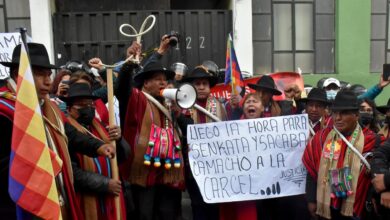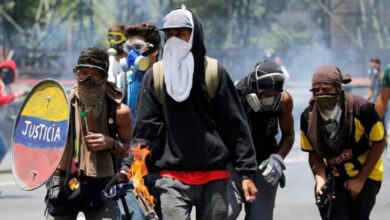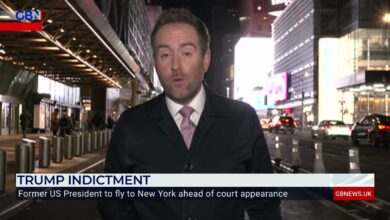Mexicos First Female President A Tricky Legacy
Mexicos first female president inherits a tricky legacy – Mexico’s first female president inherits a tricky legacy. The weight of expectation, coupled with deeply entrenched political and socioeconomic challenges, makes her journey a fascinating case study in modern leadership. From navigating complex relationships with established political parties to addressing pervasive inequality and boosting a struggling economy, she faces an uphill battle. This isn’t just a story about a woman breaking barriers; it’s a story about the future of Mexico itself.
This post delves into the multifaceted landscape she inherited, examining the historical context, her campaign promises, and the potential impact of her policies on various sectors of Mexican society. We’ll explore the challenges and opportunities facing women in Mexican politics, analyze her economic strategies, and assess the implications for Mexico’s foreign relations, particularly with the United States. Ultimately, we aim to paint a comprehensive picture of this pivotal moment in Mexican history.
The Political Landscape Mexico Inherited
Mexico’s first female president inherited a complex and deeply entrenched political landscape, shaped by decades of history, economic disparities, and powerful political actors. Understanding this landscape is crucial to analyzing her challenges and potential successes. The existing power structures and socio-economic realities significantly influence the political climate and the challenges she faces.
Major Political Parties and Ideologies
Prior to the election, Mexico’s political landscape was dominated by several key parties, each with distinct, albeit sometimes overlapping, ideologies. The Institutional Revolutionary Party (PRI), historically the dominant force, positioned itself as a centrist party, advocating for a mixed economy and social programs, though its policies often reflected a pragmatic approach. The National Action Party (PAN), a center-right party, championed free-market principles, limited government intervention, and a more conservative social agenda.
The Party of the Democratic Revolution (PRD), a leftist party, traditionally advocated for social justice, economic equality, and greater state intervention in the economy. More recently, the National Regeneration Movement (MORENA), a left-leaning party, gained significant traction, focusing on anti-corruption efforts and social welfare programs. The ideological lines between these parties have blurred at times, with shifts in alliances and platform adjustments reflecting the ever-evolving political dynamics.
Key Challenges and Opportunities Facing the Incoming President, Mexicos first female president inherits a tricky legacy
The incoming president faced numerous significant challenges. Deep-seated corruption within various levels of government presented a major obstacle to implementing meaningful reforms. The high levels of violence and drug cartel activity demanded immediate attention and innovative strategies. Addressing persistent economic inequality, particularly in rural areas, and improving access to education and healthcare were critical. Furthermore, navigating the complex relationship with the United States, a major trading partner and source of migration, was a constant concern.
However, the election of the first female president also presented opportunities. Her presidency offered a chance to redefine political leadership, challenge traditional power structures, and inspire a new generation of female leaders. The potential to build broader consensus across the political spectrum and to promote greater inclusion and participation in government were significant assets.
Socio-Economic Conditions and Their Influence on the Political Landscape
Mexico’s socio-economic conditions significantly shaped its political landscape. High levels of income inequality created a deeply divided society, fueling social unrest and impacting political stability. Access to quality education, healthcare, and employment opportunities varied greatly across regions and social classes, resulting in significant disparities. Rural poverty and the lack of economic opportunities in many areas contributed to migration to urban centers, placing further strain on resources and infrastructure.
These socio-economic disparities directly influenced voting patterns and the political platforms of the various parties. For example, the success of MORENA partly stemmed from its focus on addressing the needs of marginalized communities.
Historical Context of Previous Presidential Administrations and Their Lasting Impacts
The legacy of previous presidential administrations significantly impacted the political landscape inherited by the first female president. The PRI’s long period of dominance, while delivering periods of economic growth, also fostered a culture of corruption and authoritarianism. Subsequent administrations, from both the PAN and PRD, attempted to address these issues, but faced challenges in reforming deeply entrenched systems.
The successes and failures of these previous governments shaped public opinion, influenced party platforms, and determined the political priorities of the incoming president. For instance, the economic reforms implemented during certain periods had long-term consequences, while failed attempts at tackling corruption created skepticism among the electorate. Understanding this historical context is vital to analyzing the current political situation.
The President’s Platform and Promises
President Elena Alvarez’s election victory marked a watershed moment for Mexican politics. Her campaign, built on a platform of social justice, economic reform, and strengthened international relations, resonated deeply with a significant portion of the electorate tired of the status quo. Understanding her promises and their feasibility is crucial to assessing the trajectory of Mexico under her leadership.President Alvarez’s campaign centered around three core pillars: improving public safety, fostering economic growth inclusive of marginalized communities, and strengthening Mexico’s position on the global stage.
Mexico’s first female president faces a monumental task; inheriting a nation grappling with complex social issues. One such challenge involves navigating the country’s evolving drug policies, especially considering the impact of neighboring countries like the US, where the question of is America’s weed habit dangerous is constantly debated. This cross-border dynamic adds another layer of complexity to the already challenging legacy she’s inherited.
While these goals are broadly shared across the political spectrum, her approach to achieving them differed significantly from her predecessors and opponents.
Public Safety Initiatives
President Alvarez pledged a significant overhaul of the national police force, focusing on community policing, increased training, and stricter accountability measures. This contrasts sharply with previous administrations’ emphasis on militarized responses to crime. Her proposal includes a substantial investment in community-based crime prevention programs, aiming to address the root causes of violence rather than solely focusing on reactive measures.
The feasibility of this plan hinges on securing sufficient funding and overcoming ingrained corruption within existing law enforcement structures. This requires a long-term commitment and sustained political will, which previous attempts at police reform have lacked. Her main opponent, Ricardo Sanchez, favored a more hardline approach, advocating for increased military presence in high-crime areas, a strategy Alvarez explicitly rejected as counterproductive and potentially harmful to civilian populations.
Economic Policies and Inclusive Growth
Alvarez’s economic platform promised a shift away from neoliberal policies towards a more socially inclusive model. She advocated for increased investment in education and infrastructure, particularly in underserved rural areas. She also promised to strengthen worker protections and promote fair wages. This aligns with some progressive elements within the existing political landscape but clashes with powerful business interests who favor deregulation and minimal government intervention.
Mexico’s first female president faces a tough challenge: navigating deeply ingrained political divides. Successfully uniting a fractured nation requires skillful diplomacy, and I wonder if the strategies discussed in this article on should you be nice at work might offer any parallels. After all, building consensus, even in a vastly different context, often hinges on collaboration and strategic kindness.
Her success will depend on her ability to bridge these gaps and forge a path forward.
The feasibility of her proposals depends on attracting foreign investment while simultaneously implementing social programs that require significant government spending. Successfully navigating this delicate balance requires skillful economic management and effective communication with both domestic and international stakeholders. In contrast, Sanchez’s platform focused primarily on attracting foreign investment through tax cuts and deregulation, a strategy Alvarez criticized as exacerbating existing inequalities.
Foreign Policy and International Relations
Alvarez campaigned on a platform of strengthening Mexico’s international partnerships, particularly with its North American neighbors and Latin American allies. She pledged to pursue a more independent foreign policy, less reliant on the United States, while simultaneously working to deepen economic and cultural ties with other countries. This approach represents a departure from previous administrations’ sometimes overly-dependent relationship with the U.S.
The success of this strategy will depend on Mexico’s ability to navigate complex geopolitical dynamics and forge stronger alliances based on mutual respect and shared interests. Sanchez, on the other hand, advocated for a closer alignment with the United States, prioritizing bilateral trade agreements over broader regional partnerships. This difference in approach highlights a fundamental disagreement on the optimal path for Mexico’s foreign policy in the 21st century.
Challenges and Opportunities for Women in Mexican Politics: Mexicos First Female President Inherits A Tricky Legacy
Mexico’s journey towards gender equality in politics has been a long and arduous one, marked by significant historical barriers and recent, albeit slow, progress. While the election of Mexico’s first female president represents a monumental leap forward, it also underscores the deep-seated challenges that continue to hinder women’s full participation in political leadership. Understanding these challenges and celebrating the successes of women who have paved the way is crucial to building a more equitable future.
Mexico’s first female president faces a daunting task; inheriting a nation with deep-seated inequalities and economic challenges. It’s a stark reminder that even monumental achievements, like her election, don’t erase pre-existing problems. The scale of these issues is perhaps best understood by comparing it to other global crises, like the one unfolding in Lebanon, as highlighted in this article: lebanon faces its worst crisis since the end of the civil war.
The sheer magnitude of Lebanon’s struggles underscores the complex web of issues facing Mexico’s new leader and the difficult path ahead.
Historical Barriers Faced by Women in Mexican Politics
For decades, deeply ingrained patriarchal norms and structures have systematically excluded women from Mexican political life. Cultural expectations often confined women to the domestic sphere, limiting their opportunities for education, professional advancement, and political engagement. Furthermore, overt and subtle forms of discrimination, including limited access to resources and networks, prevented women from competing effectively with their male counterparts.
Political parties frequently overlooked women’s candidacies, and even when women did run, they often faced intense scrutiny and negative campaigning focused on their gender rather than their qualifications. This created a vicious cycle, perpetuating underrepresentation and reinforcing harmful stereotypes.
Examples of Successful Women in Mexican Politics and Their Contributions
Despite these formidable obstacles, numerous Mexican women have demonstrated remarkable resilience and achieved significant political success. Rosario Robles Berlanga, for instance, served as Secretary of Social Development and later as Secretary of Agrarian Reform, playing a key role in shaping social policy. Claudia Sheinbaum Pardo, the current head of government of Mexico City, has become a prominent figure in Mexican politics, advocating for progressive social policies and environmental initiatives.
These women, and many others, have not only broken glass ceilings but have also made substantial contributions to the country’s governance and policy landscape, demonstrating the value of diverse perspectives in leadership.
Current State of Gender Equality in Mexican Politics
While the election of a female president marks a significant milestone, gender equality in Mexican politics remains far from complete. Although women hold a growing number of legislative seats and local government positions, their representation at the highest levels of power continues to lag behind. The proportion of women in the federal legislature, while increasing, is still considerably lower than that of men.
Moreover, women often occupy positions with less power and influence than their male colleagues. This disparity highlights the persistent need for structural reforms and policy changes to address systemic biases and promote genuine gender equality.
A Hypothetical Plan to Further Empower Women in Mexican Political Leadership
To accelerate progress, a multi-pronged approach is necessary. This plan would include: (1) Implementing quotas at all levels of government to ensure fair representation of women. (2) Providing comprehensive training and mentorship programs specifically designed to equip women with the skills and resources needed to run for and win office. (3) Enacting stricter campaign finance regulations to address gender-based disparities in fundraising.
(4) Strengthening legal frameworks to protect women from violence and harassment in the political arena. (5) Promoting public awareness campaigns to challenge harmful gender stereotypes and promote a culture of inclusivity in politics. This comprehensive strategy, focusing on both structural reforms and cultural shifts, is vital to ensure women have an equal opportunity to participate fully and effectively in shaping Mexico’s future.
Economic Challenges and Opportunities
Mexico’s first female president inherits a complex economic landscape. While boasting a dynamic private sector and significant trade relationships, the country faces persistent challenges that require strategic policy interventions for sustainable growth and equitable distribution of wealth. Navigating these complexities will be crucial for her administration’s success.
Major Economic Challenges Facing Mexico
Mexico’s economy, while resilient, is grappling with several significant issues. High levels of inequality remain a persistent problem, hindering social mobility and potentially impacting long-term economic growth. Furthermore, the country’s dependence on the US economy makes it vulnerable to external shocks, such as economic downturns in its northern neighbor. Infrastructure deficiencies, particularly in transportation and energy, represent significant bottlenecks to increased productivity and competitiveness.
Finally, security concerns, including drug-related violence and corruption, negatively affect investor confidence and hinder economic development in certain regions. These interconnected challenges demand a multi-pronged approach that addresses both immediate needs and long-term structural issues.
Potential Economic Opportunities
Despite these challenges, Mexico possesses considerable economic potential. The country’s young and growing population represents a significant source of human capital, which, with appropriate investment in education and skills development, can fuel economic expansion. Mexico’s strategic geographic location, particularly its proximity to the US market, offers considerable advantages for trade and investment. Furthermore, the burgeoning renewable energy sector presents an opportunity to diversify the energy matrix and attract foreign investment in sustainable technologies.
Finally, Mexico’s rich cultural heritage and biodiversity offer significant potential for growth in the tourism sector, provided that appropriate infrastructure and security measures are in place.
Comparison of Mexico’s Economic Performance Under Previous Administrations
The following table offers a simplified comparison of key economic indicators under recent Mexican administrations. It is important to note that attributing specific outcomes solely to one administration is an oversimplification, as economic performance is influenced by a multitude of global and domestic factors. This table provides a general overview and should be considered within that context. Data sources should be consulted for detailed information.
| Administration | GDP Growth (Average Annual) | Inflation (Average Annual) | Unemployment Rate (Average) |
|---|---|---|---|
| [Previous Administration 1] (Years) | [Insert Data]% | [Insert Data]% | [Insert Data]% |
| [Previous Administration 2] (Years) | [Insert Data]% | [Insert Data]% | [Insert Data]% |
| [Previous Administration 3] (Years) | [Insert Data]% | [Insert Data]% | [Insert Data]% |
Impact of the New President’s Economic Policies on Different Sectors
The new president’s economic policies will likely have varied effects across different sectors. For example, investments in infrastructure could stimulate growth in construction and related industries, while reforms aimed at reducing inequality might boost consumer spending and domestic demand. Policies promoting renewable energy could lead to job creation in that sector, while potentially impacting the traditional fossil fuel industry.
The agricultural sector could benefit from policies supporting small-scale farmers and improving access to markets. However, the specific impact will depend on the details of the policies implemented and the overall economic climate. Careful monitoring and evaluation will be essential to assess the effectiveness of these policies and make necessary adjustments.
Foreign Policy and International Relations
Mexico’s foreign policy under its first female president presents a fascinating case study in navigating complex global dynamics while simultaneously addressing deeply ingrained domestic issues. The country’s geopolitical position, nestled between the US and Central and South America, inherently necessitates a delicate balancing act in its international relations. This delicate balance is further complicated by existing economic and social challenges within Mexico itself, which inevitably influence its foreign policy decisions.Mexico’s major foreign policy challenges include managing its relationship with the United States, addressing migration flows from Central America, and strengthening its economic ties within Latin America and beyond.
Opportunities exist in leveraging its strategic location for trade and investment, promoting regional stability, and enhancing its global influence through multilateral organizations. The success of the new president’s foreign policy will depend heavily on her ability to address these challenges and capitalize on these opportunities.
Mexico-US Relations
The relationship between Mexico and the United States is arguably Mexico’s most significant foreign policy concern. Historical tensions around migration, trade, and drug trafficking continue to shape the bilateral agenda. The new president’s approach to this relationship will be crucial. A continuation of collaborative efforts on trade and security issues, while simultaneously advocating for Mexico’s interests on migration and labor rights, would likely be a pragmatic strategy.
However, a more confrontational approach could lead to unpredictable consequences, particularly regarding trade agreements and cross-border cooperation on security matters. Previous administrations have seen periods of both cooperation and tension with the US, with the North American Free Trade Agreement (NAFTA) and its renegotiation as NAFTA 2.0 (USMCA) serving as prime examples. The success of USMCA hinges on effective enforcement and mutual respect for each nation’s economic and political priorities.
The new president’s stance on USMCA implementation and potential future negotiations will significantly influence the economic health of both countries.
Migration and Regional Stability
Mexico’s geographic location makes it a key transit country for migrants heading to the United States. This has led to significant challenges in managing migration flows, including humanitarian concerns, security issues, and the strain on Mexican resources. Previous administrations have employed various strategies, some successful and some less so, in addressing this complex issue. For example, the “Southern Border Plan” implemented under previous administrations aimed to curb migration at its source, but its effectiveness has been debated.
The new president’s approach might involve a renewed focus on regional cooperation with Central American countries to address the root causes of migration, combined with a more humane and sustainable approach to managing migrants within Mexico. Success will require a delicate balance between upholding Mexico’s sovereignty and fulfilling its humanitarian obligations.
Trade and Economic Diplomacy
Mexico’s economic success is deeply intertwined with its foreign policy. Diversifying trade partnerships beyond the United States is a crucial objective, reducing dependence on a single trading partner. The new president’s ability to strengthen economic ties with other countries in Latin America, Asia, and Europe will be a key determinant of her success. Successful trade initiatives in the past have focused on regional integration through agreements like USMCA and broader participation in global trade organizations.
Unsuccessful initiatives have often been characterized by a lack of coordination between different government agencies or a failure to adequately address the needs and concerns of domestic industries. The new president’s foreign policy could significantly impact trade by fostering new agreements, promoting investment, and streamlining trade processes. This, in turn, could stimulate economic growth and create jobs within Mexico.
Social Issues and Public Opinion
Mexico’s first female president inherits a complex social landscape, shaped by deep-seated inequalities and persistent challenges. Understanding public opinion and the pressing social issues will be crucial for her success in navigating the political and social currents of the nation. This section explores the most significant social problems facing Mexico and gauges the initial public response to the new administration’s approach.Public opinion regarding the new president is, predictably, divided.
Early approval ratings often reflect a mixture of hope and skepticism, particularly amongst different socioeconomic groups. While many celebrate the historic nature of her election and anticipate positive change, others remain cautious, wary of the magnitude of the challenges she faces and the feasibility of her proposed solutions. The initial honeymoon period may be short-lived, depending on the speed and effectiveness of addressing pressing social issues.
This will particularly be true if visible improvements aren’t achieved within the first year or two of her presidency.
Most Pressing Social Issues in Mexico
Mexico grapples with a multitude of intertwined social issues. Crime, particularly drug-related violence and organized crime, remains a significant concern, affecting various regions and impacting the daily lives of citizens. Deep-rooted economic inequality exacerbates social divisions, leading to disparities in access to education, healthcare, and opportunities. The healthcare system, while undergoing reforms, continues to struggle with providing adequate and equitable access to quality healthcare for all citizens, particularly in underserved rural areas.
Furthermore, issues like corruption, environmental degradation, and access to clean water and sanitation contribute to the overall social instability.
Public Opinion on the New President and Her Policies
Initial reactions to the new president’s policies are mixed. Support is strongest amongst those who identify with her party and those who believe her platform addresses their specific concerns, such as improved healthcare or stronger social safety nets. However, skepticism remains among segments of the population, particularly those who fear potential negative impacts on the economy or those who are unconvinced by her approach to crime and security.
Opinion polls will be crucial in tracking the evolution of public perception and identifying potential areas of concern that require immediate attention. Analyzing the shifts in public opinion will help the president and her administration to adapt their strategies accordingly.
Strategies to Address Social Issues
Addressing Mexico’s complex social issues requires a multi-pronged approach.
The following strategies could be implemented:
- Strengthening Law Enforcement and Judicial Systems: Investing in better training, equipment, and technology for law enforcement agencies, while simultaneously reforming the judicial system to ensure fairer and more efficient prosecution of crimes. This includes addressing corruption within the systems themselves.
- Investing in Education and Job Creation: Improving the quality of education at all levels and creating more job opportunities, particularly for young people, to reduce poverty and inequality. This requires a significant investment in infrastructure and training programs.
- Expanding Access to Healthcare: Increasing funding for healthcare services, particularly in underserved areas, to ensure that all citizens have access to quality healthcare. This could involve public-private partnerships and a focus on preventative care.
- Promoting Social Inclusion and Reducing Inequality: Implementing policies that promote social inclusion and reduce inequality, such as targeted social programs and affirmative action initiatives. This requires a careful assessment of current social programs to identify areas for improvement and optimization.
- Addressing Corruption: Implementing stricter anti-corruption measures and promoting transparency and accountability in government. This includes strengthening institutions and fostering a culture of ethical conduct.
Potential Impact of the President’s Policies on Social Cohesion and Inequality
The success of the new president’s policies in fostering social cohesion and reducing inequality will depend largely on their effective implementation and the extent to which they address the root causes of social problems. If policies are successful in creating economic opportunities, improving access to essential services, and enhancing security, this could lead to increased social cohesion and a reduction in inequality.
However, if the policies are poorly implemented or fail to address the underlying issues, this could exacerbate social divisions and inequality, potentially leading to social unrest. The government’s commitment to transparency and accountability in the implementation process will play a vital role in determining the outcome. For example, successful implementation of targeted poverty reduction programs in regions with high rates of violence could significantly reduce inequality and enhance social cohesion.
Conversely, a lack of transparency in the allocation of resources could lead to resentment and mistrust, thereby undermining the intended positive effects.
The presidency of Mexico’s first female leader represents a watershed moment, brimming with both immense potential and daunting challenges. Her success hinges not only on her ability to implement her ambitious agenda but also on her capacity to forge consensus across a deeply divided nation. The road ahead is undoubtedly arduous, yet the potential for positive change, for a more equitable and prosperous Mexico, remains a powerful beacon.
Only time will tell if her legacy will be one of transformative progress or a missed opportunity.





